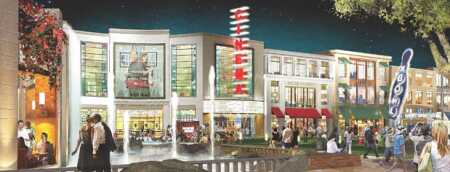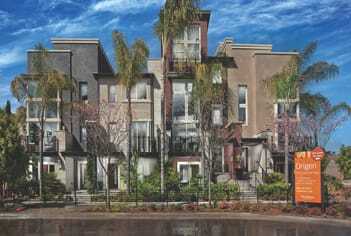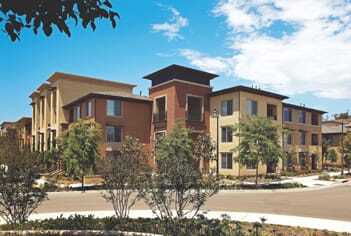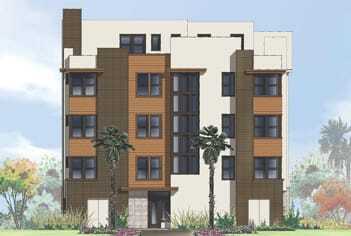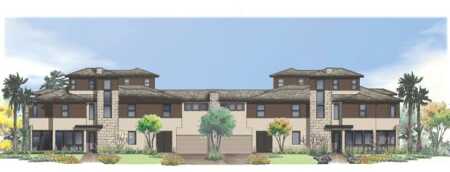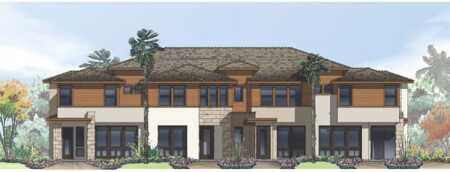Designed by local architect and planner Gordon Carrier, a principal at Carrier Johnson & Culture, the project is creating a high-density urban village organized around a network of parks and open space, with housing, retail, office, and civic components linked by pedestrian trails, walkable streets, and bike paths.
Formerly known as Quarry Falls, Civita is a joint venture of locally based Sudberry Properties and the Grant Family Trust, which has owned the property since the late 1920s. Mined for 70 years, the site’s hillside had been bored down to the water table and the pit was filled with rubble and trash, says Colton Sudberry, president and chief executive officer of the Sudberry development company. He notes that Vulcan Materials, the last company to mine the sand and gravel quarry, built the site up 30 feet (9 m) with engineered fill to create a stable foundation.
Plans call for 60 to 70 acres (24 to 28 ha) of parks and open space; 4,780 residential units; and 900,000 square feet (83,613 sq m) of commercial space in three components. Commercial development includes the following: Village Walk, a town center with 400,000 square feet (37,161 sq m) of retail amenities and possibly some housing and office space; an urban village center, with a mix of affordable housing integrated vertically with 100,000 square feet (9,290 sq m) of neighborhood retail and possibly boutique office space; and a stand-alone office campus with 400,000 square feet (37,161 sq m) of Class A space.
Walkable by Design
The $2 billion project embraces San Diego’s “City of Villages” planning concept, which calls for everything needed by residents to be within walking distance of their homes or accessible by mass transit, says Brian Schoenfisch, the city’s senior planner for the project.
“A strong point of this development is it provides an opportunity to live within Mission Valley, which is one of the city’s job centers, without owning a car,” Schoenfisch says.
Sudberry has partnered with ECOtality, Inc., a San Francisco-based company focused on clean electric transportation and storage technologies, to install electric car chargers on Civita’s streets. “This allowed us to create a partnership with Car2Go,” says Marco Sessa, Sudberry’s senior vice president for residential and land development. Sessa says Car2Go rents Daimler-Chrysler electric “smart cars” by the minute. “This service will allow couples to manage without owning two cars,” he says.
The first phase of Civita, which is being developed in four phases over ten years, is now half completed. Phase I will include four apartment complexes with a total of 1,218 units, one of which will be a mixed-use project with up to 100,000 square feet (9,290 sq m) of retail space on the ground level; four for-sale condominium or townhouse projects, with a total of 399 units; 45 single-family, patio-style homes; and a 14-acre (5.6 ha) central park, with a heritage museum and amphitheater. Sessa notes that the Phase I geographic area also includes additional lots for vertical development, including four residential neighborhoods and one mixed-use block, that will be released as projects currently under development are absorbed.
Located about three miles (5 km) from downtown San Diego and the international airport, the Civita development comprises 135 acres (54 ha) of the site’s total 230.5 acres (93 ha), 95 acres (38 ha) of which is slated for residential projects; the remaining 40 acres (16 ha) will contain mixed uses and retail on the southern portion of the property, nearest to the area’s network of freeways and local thoroughfares. Friars Road, a major east–west access road lined with retail destinations, runs along the southern edge of development. Sudberry plans to build a bridge across Friars Road to provide residents with pedestrian access to the Rio Vista Station of San Diego’s light-rail trolley system and Rio Vista Shopping Center, a Sudberry-owned lifestyle center. Plans call for a shuttle service to provide regular transportation to the trolley station, probably commencing with completion of Phase II, according to Sessa.
Civita achieved a Stage 1 Gold rating for the U.S. Green Building Council’s 2009 LEED-ND (Neighborhood Development) pilot and received the 2009 Governor’s Environmental and Economic Leadership Award. It also is one of 13 projects statewide designated as a California Catalyst Community. This program is sponsored by the California Department of Housing and Community Development to support innovation and test sustainable strategies that reflect the interdependence of environmental, economic, and community health. Projects with this designation are eligible for targeted technical assistance from teams of state agencies and for bonus points when applying for specific state funding programs.
The project restores ecological integrity to the old quarry, and more than one-third of the site is devoted to open space and parks. Development is expected to surpass California’s strict Title 24 building standards, which require new buildings to reduce energy usage by 15 percent, water usage by 20 percent, and construction waste by 50 percent. Civita is expected to exceed those mandates by double-digit margins.
Residential development is designed to reduce use of water and electricity by orienting buildings to take advantage of natural ventilation and daylighting. Shade trees and other forms of vegetation are being strategically located near buildings to reduce heat gain in summer and increase warmth in winter.
Sudberry has an agreement with San Diego Gas & Electric to experiment with energy technologies, notes Sessa. Emerging technologies that conserve water and energy and generate electricity are being incorporated with tried-and-true concepts, such as photovoltaic solar panels, Energy Star appliances, and WaterSense fixtures.
In addition, Sudberry’s Circa 37—a 360-unit multifamily project that opened in January 2012—is the first apartment community in the San Diego area to install a 150-kilowatt (kW) energy-generation system. It incorporates rooftop photovoltaic solar with two 5-kW fuel cells, a technology that both generates and stores electricity; the system is expected to produce 80 percent of the electricity needed to power the complex’s common areas. Sessa points out that on-site power generation also provides the ability to deal with power outages, providing residents a lit refuge in common areas until power is restored. It also eliminates the question of who pays for recharging electric cars in the public domain.
The company is scheduled to break ground this spring on West Park, a ten-acre (4 ha), 610-unit apartment complex, which also incorporates solar with fuel-cell technology. But this project will ramp up power generation by installing six 5-kW fuel cells and adding solar panels to carport rooftops. “We also plan to eventually install interactive, smart appliances, which turn on at certain times as needed,” Sessa says, noting that this technology is still a couple of years away from being cost-effective, as smart appliances currently cost about $6,000 each.
Other opportunities for sustainability have been seized. Sand and gravel from the former quarry are being incorporated into roads; old concrete is being recycled. More shade trees will be planted than the city requires, and reclaimed water will be used for irrigation. Sudberry also plans to build a water treatment plant. “San Diego is at the end of the water pipe, so we want to control our own water destiny to the extent that we can,” Sessa explains.
Housing Affordability
About 10 percent of Civita’s residential product—478 units—will be affordable housing. Three or four affordable projects for low-income seniors and families will be sprinkled throughout the site, says Sessa. Chelsea Investments, a local affordable housing developer, was recently selected to build the first affordable project, which will consist of 150 units for seniors. He notes that the next affordable project is likely to be a mixed-use development, with housing for families and ground-floor retail services.
Sudberry is erecting market-rate rental projects in partnership with the Grant family. “We are an investment builder, in it for the long term,” says Sessa. “This makes us different [than apartment developers who build to sell] in that we are putting more [effort and money] into architecture and durable, maintenance-free components.”
The company has partnered with Shea Homes San Diego and Irvine, California-based TRI Pointe Homes to build the project’s for-sale housing. “We are trying to bring various types of housing into the mix,” Sessa explains, “and are segmenting the marketplace so we create homes that don’t compete with each other.”
He stresses, however, that housing affordability is a top goal at Civita. “We want to achieve certain price points, with entry-level homes in the $300,000s and $400,000s,” he notes.
So far, Shea is only the homebuilder with completed for-sale product. Origen, their 200-unit condominium project, opened in June 2012. It was designed by the Santa Ana, California, office of Woodley Architectural Group and is half finished, with home production based on sales, notes Paul Barnes, president of Shea Homes San Diego. Units range from about 1,400 to 2,100 square feet (130 to 195 sq m) and are priced from the mid-$400,000s to the mid-$500,000s.
The company also expects to open three new communities this year. Two communities, Focus and Frame, are scheduled to open in October. Focus is a project of 64 rowhomes measuring 1,585 to 1,983 square feet (147 to 184 sq m) with small yards, priced in the low $400,000s. Frame, priced in the high $400,000s, will offer 76 two-story townhomes with a motor-court parking configuration, in which units are wrapped around a central garage to allow residents to enter their homes directly from the garage.
Lucent, a four-story condominium community offering one-story luxury flats, is scheduled to begin sales in December. Units will range from 1,467 to 2,078 square feet (136 to 193 sq m), with prices from the $500,000s to the $600,000s. The project is geared to people who prefer one-level living, with elevator access and motor-court-style parking.
Builder TRI Pointe is scheduled to begin home sales at the Altana community in June. It will include 45 detached patio-style homes on 3.5-acre (1.4 ha) lots. Homes ranging from 1,668 to 2,180 square feet (155 to 202 sq m) will have base prices from the high $500,000s to the mid-$600,000s. Homes will be configured in a courtyard layout, on an elevated site adjacent to the community’s main paseo and central park.
A Return to Ecological Health
Every aspect of the project’s design is intended to enhance quality of life and create value for residents, with thoughtful, innovative planning to create a healthy, sustainable environment and unique identity for the community, according to Sessa, who suggests that Civita provides a truly urban infill environment combined with suburban master-planning concepts.
Biomimicry was used to create an ecologically natural drainage system and reestablish plant and animal habitats. Twenty-five acres (10 ha) of slopes left from mining operations were revegetated with native plants and terraced. The terraced hillside offers scenic elevations, but—of greater importance—acts as a conduit for stormwater runoff and helps prevent erosion.
A dry creek running through the property was designed as a bioswale to collect and clean stormwater of pollutants as it flows slowly into a retention pond, which doubles as a water feature, Sudberry says, noting that the water eventually flows into the San Diego River, which empties into Mission Bay.
“The creek is the right width and depth to support natural drainage without water piping under streets, so our streets could be narrower than traditional streets,” Sessa notes. He explains that the advantage of narrow streets is room for extra-wide sidewalks and additional landscaping between the streets and sidewalks, which increase safety for pedestrians.
Residential buildings are positioned so that residences have entry on the street, with lower units having a stoop where residents can relax, creating energy on streets. Public domain areas have enhanced architectural and landscaping elements to fashion an identity for the community. Enhancements include artwork and designer features, such as stamped-concrete paving and tile, as well as whimsical elements that support identity in the public realm, like castings, famous quotes, and funny sayings—"stuff that makes people smile when they walk around,” Sessa says.
Civita’s Specific Plan includes a public parks system designed by the Schmidt Design Group of San Diego, a firm that specializes in designing sustainable public spaces. The plan calls for a 14-acre (5.6 ha) central park and several smaller neighborhood and pocket parks.
The central park—construction of which is about to get underway—will be linked to all Civita neighborhoods with a network of pedestrian trails and bike paths. The plan calls for a variety of active and passive amenities, including sports and recreation facilities, such as basketball and volleyball courts, a fitness course, trails, and playgrounds, as well as pastoral areas with picnic tables and barbecue grills and seating located at viewpoints. The park will serve as a gathering place for community events and include an amphitheater and Heritage Museum that will be operated by the San Diego River Park Foundation.
Long Wait for Approvals
While Civita may be an example of innovation, smart growth, and sustainability, getting the project entitled was a major challenge for the developer. The design/entitlement process began in early 2002, with the city council finally approving Civita’s Environmental Impact Report and Specific Plan in 2008. But development did not begin until 2010, when final maps were approved, notes Sessa. “So [approvals took] a total of nine years,” he says. “It’s become a habit to say almost a decade.”
Sudberry notes that the lengthy approval process was due in part to the scale and density of the project. The density, which ranges from seven to 100 units per acre (17 to 247 units per ha), raised concerns about how the project would affect existing infrastructure and traffic patterns. The city required traffic studies to determine how the project would affect local intersections, as well as freeway on- and off-ramps.
Another issue involves the site’s location in two planning districts. About six acres (2.4 ha) lie within the Serra Mesa planning district and the rest lies in Mission Valley. “Serra Mesa didn’t want a road connection from Mission Valley, but Mission Valley did,” Sudberry notes. “We did traffic studies with and without it, but no one could make a decision. The city finally approved the plan and is now doing its own traffic study, but we redesigned the street grid so we can go either way.”
Acknowledging the lengthy approval process, Schoenfisch notes, “This was sort of a laboratory of new concepts for sustainability.” But he explains that other issues evolved as a result of new state regulations coming on line during the entitlement period, including AB 32 and SB 375.
AB 32 requires local governments to reduce greenhouse gas emissions (GHGs) to 1990 levels by 2020. SB 375 sets GHG targets for different regions and connects land use to AB 32 goals. It seeks to eliminate sprawl by encouraging cities to adopt a general plan with a sustainable-communities strategy, which requires new development to be near transit or clustered with existing development. Local governments are not required to comply with SB 375; but if they do not, they will not share in the state’s annual $6 billion transportation fund.
Sessa notes that all the challenges and perseverance “translate into higher values and greater absorption.” As for the city’s benefits, Schoenfisch says, “At the end of the day, we [the city] ended up with a showcase project. It is a good model we can point to when other developers come in with a project to show [them] ‘this is what we want to see in your project.’”

